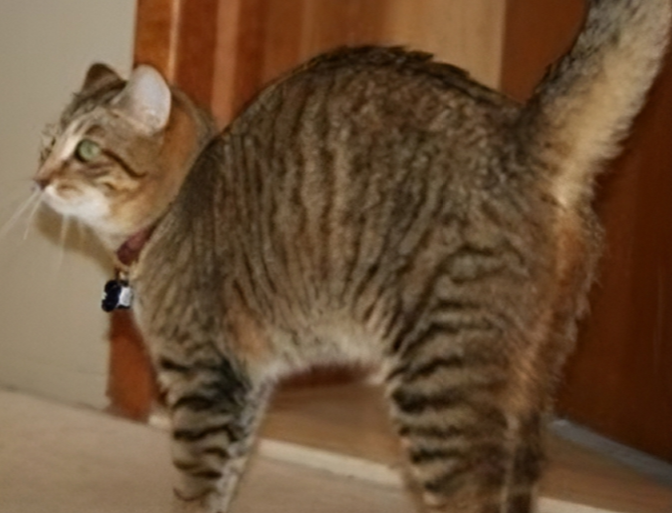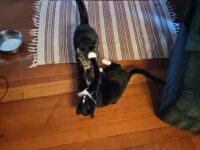Understanding the subtle and obvious behaviors cats use to communicate with each other is essential in maintaining a peaceful multi-cat household. By observing these signals, you can better understand whether your cats are comfortable together or if there might be tension which is quite common but should be addressed in order to maintain the best quality of life for your cats.
Signs That Cats Like Each Other
Cats that enjoy each other’s company often display behaviors that encourage closeness:
- Mutual Grooming: They frequently groom each other.

- Sleeping Together: They often sleep in close contact and may face each other or touch.
- Friendly Approaches: When they approach each other, their tails are up, and they often touch noses or rub heads or sides.
- Balanced Play: Play is mutual, with each cat taking turns chasing the other. If only one cat does the chasing, it is not play.
- Initiating Interaction: Either cat may start an interaction.
Signs of Possible Tension Between Cats
Tension between cats can be passive and subtle, or active and obvious. Here are behaviors to watch for:
Passive and Subtle Signs:
- Prolonged Staring: Especially when the other cat is moving.
- Guarding or Blocking Resources: Such as food, water, sleeping spots, litter boxes, or toys.
- Avoidance: Staying far apart and/or away from each other, or hiding.
- Vocalizations: Low growls or hisses.
- Refusal to Enter Rooms: One cat may refuse to enter a room if the other cat is present. This is a great concern if that room contains any of a cat’s key resources such as food, water, litter box, bed, safe place to rest or hide, etc.
- Change in Normal Behaviors: This can range from not eating, inactivity, disturbed sleep, overgrooming, scratching, urine marking, or not using the litter box.
Active and Obvious Signs:
- Cornering or Chasing: One cat corners, chases, or stalks the other.
- Physical Contact: Biting, swatting, or scratching.
- Vocalization: Loud growls, yowls, or hisses.
- Fighting: Including hissing, growling, chasing, swatting, and pinning.
- Body Positions: Arched back (e.g., “Halloween pose”), raised hair, crouched body, fixated stare, flattened ears, and swishing or a puffed tail.
If you notice any of these subtle or obvious signs, contact your veterinarian right away. If intercat tension exists in your household, you may be able to utilize behavior modification to teach your cats to become tolerant of one another, follow a step-by-step process to re-integrate your cats by starting one cat in a transition room, or in some cases a professional board-certified behaviorist may need to help. Tension can cause a cat distress which can cause stress-associated disease, and could possibly lead to relinquishment or euthanasia, so it is extremely important to address any intercat tension.
Understanding Your Cat’s (or Cats’) Body Language
 This cat is hissing, which means it is feeling scared or protective. The cat is staring intently, with a tense body and ears flattened back. This cat is hissing, which means it is feeling scared or protective. The cat is staring intently, with a tense body and ears flattened back. |  This cat’s back is arched, has raised fur, and is standing on tiptoes to look bigger. This is a sign they feel threatened. This cat’s back is arched, has raised fur, and is standing on tiptoes to look bigger. This is a sign they feel threatened. |  This cat has dilated pupils, a tense body, and fixated stare, with ears flattened. This cat has dilated pupils, a tense body, and fixated stare, with ears flattened. |
 Tension between two cats in a multi-cat household. The black cat frequently intimidates the tabby without physical conflict. (a) The tabby cowers as the black cat stares. (b) The tabby hisses, tense and with flattened ears. (c) Direct conflict: swiping and hissing, with the black cat’s ears rotated. (d) The tabby freezes and leans away tensely as the black cat stares. (e) The tabby slowly retreats, crouched under the black cat’s watchful eye. | ||
Minimal-concern Behaviors
Some behaviors may not indicate tension as long as they are infrequent, do not escalate, and the cats are happy to see each other during their next interaction. Examples include a random “Meow!” or head tap, grooming that ends in a brief tussle, or a short chase. After such incidents, the cats may separate for a while but remain friendly when they meet again. However, if you notice any of these signs increasing in frequency or escalating to other possible signs of tension, contact your veterinarian right away.
By recognizing these behaviors, you can better understand your cats’ relationships and take steps to ensure a harmonious multi-cat household. Regular observation and timely intervention can help prevent minor tension from escalating into serious conflicts, promoting a peaceful and happy environment for all your feline friends.
How to Find a Qualified Feline Behaviorist
Several organizations certify that individuals have met the knowledge requirements and clinical experience to provide behavioral counseling and possibly medical interventions for cats with behavioral problems. The following websites contain directories of qualified behaviorists:
Board Certified Veterinary Behaviorists
- American College of Veterinary Behaviorists (ACVB)
- European College of Animal Welfare and Behavioral Medicine (ECAWBM)
- Australian and New Zealand College of Veterinary Scientists (FANZCVS)
- American Board of Veterinary Practitioners (ABVP)
Although not certified as specialists in feline behavior, Feline Diplomates of ABVP have advanced training in many areas of feline medicine including behavior, and may be helpful if a behavior specialist is not available in your area or they can reach out to one for a cooperative consultation.
Animal Behavior Societies
- Animal Behavior Society – Not all certified behaviorists are veterinarians; only those who are licensed veterinarians can provide medical treatment and prescribe drug therapy.
- Canadian Certified Animal Behaviorist (CCAB)
- American Certified Applied Animal Behaviorist (ACAAB)




